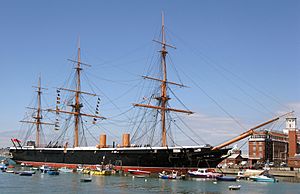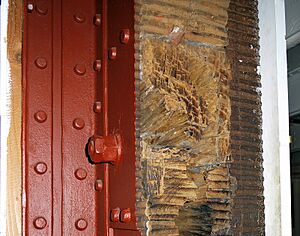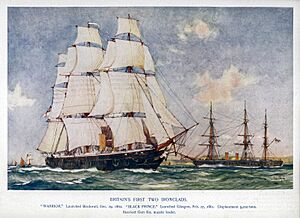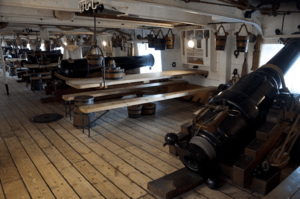HMS Warrior (1860) facts for kids

Warrior
|
|
Quick facts for kids History |
|
|---|---|
| Name | Warrior |
| Ordered | 11 May 1859 |
| Builder | Thames Ironworks and Shipbuilding Company, Blackwall, London |
| Cost | £377,292 |
| Laid down | after 6 June 1859 |
| Launched | 29 December 1860 |
| Completed | 24 October 1861 |
| Commissioned | 1 August 1861 |
| Decommissioned | 31 May 1883 |
| Renamed |
|
| Status | Museum ship (50°47′54″N 01°06′32″W / 50.79833°N 1.10889°W) |
| General characteristics | |
| Class and type | Warrior-class armoured frigate |
| Displacement | 9,137 long tons (9,284 t) |
| Length | 420 ft (128.0 m) (o/a) |
| Beam | 58 ft 4 in (17.8 m) |
| Draught | 26 ft 10 in (8.2 m) |
| Installed power |
|
| Propulsion | 1 shaft; 1 Trunk steam engine |
| Sail plan | Ship rig |
| Speed | 14 knots (26 km/h; 16 mph) |
| Range | 2,100 nmi (3,900 km; 2,400 mi) at 11 kn (20 km/h; 13 mph) |
| Complement | 706 officers and ratings |
| Armament |
|
| Armour |
|
HMS Warrior was a powerful warship built for the Royal Navy between 1859 and 1861. She was a 40-gun, steam-powered armoured frigate. Warrior and her sister ship HMS Black Prince were special. They were the first warships with an iron hull covered in armor plates.
These ships were built because France launched the Gloire in 1859. Gloire was the world's first ocean-going ironclad. Britain needed a ship that could match it.
Warrior had an active career with the Channel Squadron. She became less important after 1873 when newer, more advanced ships were built. She was taken out of service in 1883.
After her naval career, Warrior served in different roles. She was a storeship, a depot ship, and even an oil jetty. In 1979, the Navy gave her to The Maritime Trust for restoration. After eight years of hard work, she became a museum ship. Today, Warrior is based in Portsmouth and is part of the National Historic Fleet.
Contents
Why HMS Warrior Was Built
In 1850, France launched a steam-powered warship called Napoléon. This started a competition between France and Britain to build better warships. This competition lasted for ten years.
During the Crimean War, battles like Battle of Sinop showed something important. Wooden ships were easily destroyed by explosive shells. But armored ships, like the French floating batteries at the Battle of Kinburn, could survive attacks.
When France launched Gloire in 1859, it changed everything. Britain's wooden ships seemed outdated. People in Britain worried about a possible invasion. Even Queen Victoria asked if the navy was strong enough. Warrior and her sister ship were ordered to solve this problem.
The Admiralty wanted Warrior to be fast, reaching 15 knots. She also needed sails for long journeys around the world. Iron was chosen for the hull because it was lighter than wood. This allowed for more guns, armor, and powerful engines.
Designing a Powerful Warship
How Warrior Was Designed
Isaac Watts, the Navy's Chief Constructor, and Thomas Lloyd, the Chief Engineer, designed Warrior. To make sure the design was safe, they used a proven hull shape. They copied the design of a large wooden frigate called HMS Mersey.
They changed the design to use iron and to include an armored box in the middle. This box, called a citadel, protected most of the ship's guns. Ships with this setup are known as broadside ironclads.
Warrior used many technologies that were already common. These included her iron hull, marine steam engine, and screw propeller. The main new thing was her wrought-iron armor.
Naval expert David K. Brown said Warrior was special because all these parts worked together. This made her the biggest and most powerful warship in the world. She was faster, better armored, and harder to hit than any other ship. The Admiralty stopped building wooden ships and ordered 11 more ironclads.
Jacky Fisher, who served on Warrior, later said that people didn't realize how much she would change naval warfare.
Warrior's Size and Shape
Warrior was designed to be different from Gloire. The French ship was meant to replace wooden ships of the line. But Warrior was a 40-gun armored frigate. She was designed to be fast enough to chase enemies and control how far away battles were fought.
Warrior has a sleek clipper bow. She is twice as long as a typical clipper ship. Her total length is 420 feet (128 meters). She is 58 feet 4 inches (17.78 meters) wide. Her draught (how deep she sits in the water) is 26 feet 9 inches (8.15 meters).
The ship weighs 9,137 long tons. Her long shape made her less easy to turn. This made it harder to use her strengthened front for ramming, a battle tactic used back then. The hull had 92 watertight compartments. She also had a double bottom under the engine and boiler rooms.
Guns and Weapons
Warrior was first planned to have 40 smoothbore, muzzle-loading 68-pounder guns. These guns could fire a solid shot 3,200 yards (2,900 meters).
During construction, her weapons were changed. She received 10 Armstrong 110-pounder guns. These were early rifled breech loaders. She also had 26 68-pounders and four Armstrong 40-pounder guns. The 40-pounders could reach 3,800 yards (3,500 meters).
The 110-pounder guns were new but had problems. They didn't work well in tests against armor. In one battle, a gun was loaded wrong, and part of it blew out. They were also hard to load. So, they were used with less gunpowder, making them weak against armored ships.
All the guns could fire solid shot or explosive shells. The 68-pounders could even fire molten iron shells. In 1863, the 40-pounders were replaced with better ones.
During a refit from 1864 to 1867, Warrior got new weapons. She received 24 7-inch and four 8-inch rifled muzzle-loading (RML) guns. She also got four 20-pounder Armstrong guns for saluting. The new 8-inch RML guns could pierce 9.6 inches (240 mm) of iron armor.
Strong Armor Protection
Warrior had very strong armor. It was made of 4.5 inches (114 mm) of wrought iron. Behind the iron was 18 inches (457 mm) of teak wood. The iron plates fit together like a puzzle. They were bolted through the teak to the iron hull.
The teak wood had two 9-inch (229 mm) layers placed at right angles. This wood helped absorb the shock from enemy shells. This prevented the bolts holding the armor from breaking. Unlike later ships, Warrior's armor was hammered, not rolled.
Tests in 1861 showed that Warrior's armor was almost impossible to break with the guns used at that time.
The armor covered the middle 213 feet (64.9 meters) of the ship. It went 16 feet (4.9 meters) above the waterline and 6 feet (1.8 meters) below it. The guns on the main deck were protected from side attacks by 4.5-inch (114 mm) walls. The front and back of the ship had no armor. However, they had watertight compartments to stop flooding. The lack of armor at the back made the steering system vulnerable.
Life Aboard for the Crew
In 1863, Warrior had a crew of 50 officers and 656 ratings (sailors). Many tasks were physically demanding. For example, raising the ship's huge anchors required a lot of strength. Daily life for the crew was similar to that on older wooden ships.
Most of the crew lived on the single gun deck. They slept in hammocks hung between the guns. Up to 18 men shared the space between each pair of guns. Officers had small private cabins at the back of the ship. Their dining area was called the wardroom. The captain had two large, comfortable cabins.
122 of the ratings were Royal Marines. At first, all of Warrior's marines were from the Royal Marine Artillery. Later, some marine infantrymen were also assigned, which was the usual practice. The marines operated the back guns and slept near the officers' cabins.
How Warrior Moved
Warrior had a two-cylinder trunk steam engine built by John Penn and Sons. This engine powered a single propeller. Steam came from 10 rectangular boilers. During sea trials in 1868, the engine produced 5,772 horsepower. This gave the ship a speed of 14.08 knots using only steam.
The ship carried 853 long tons of coal. This was enough to steam 2,100 nautical miles (3,900 km) at 11 knots.
Warrior also had a full set of sails, like a ship rig. Her sails covered an area of 48,400 square feet (4,500 square meters). She could reach 13 knots using only sails. This was 2 knots faster than her sister ship, Black Prince.
She had the largest propeller ever made that could be lifted out of the water. It weighed 26 long tons. 600 men were needed to raise it into the ship. This reduced drag when the ship was sailing. To further reduce drag, both her funnels could be lowered. Once, using both sails and steam, she reached 17.5 knots.
Figurehead of HMS Warrior
Warrior had a figurehead (a carved figure at the front of the ship). The first one was approved in 1860 and carved by Hellyer & Sons.
This first figurehead was lost in 1868 when Warrior crashed into HMS Royal Oak. The Hellyers carved a new one, also a traditional warrior figure.
This second figurehead was displayed at HMNB Portsmouth from 1900 to 1963. But it rotted away due to weather and was destroyed.
The third and current figurehead was carved between 1981 and 1983. Jack Whitehead and Norman Gaches carved it for the ship's restoration. You can see it on the bow of Warrior today.
Warrior was ordered on May 11, 1859, from Thames Ironworks and Shipbuilding Company in Blackwall, London. Her construction began in mid-August 1859. The Admiralty often changed the design, causing delays. This almost made the builders go bankrupt. They received £50,000 to keep working.
She was launched on December 29, 1860, during a very cold winter. She was frozen to her slipway! Workers had to use hydraulic rams, extra tugs, and rock the ship to free her.
Warrior was officially put into service in August 1861 for sea trials. She was finished on October 24, 1861, costing £377,292. This was almost twice the cost of a wooden warship at the time.
Early Years and Public Tours
Warrior joined the Channel Squadron under Captain Arthur Cochrane. In March 1863, she escorted the royal yacht carrying Princess Alexandra of Denmark to Britain. The princess was coming to marry the Prince of Wales. She was very impressed with the crew.
In mid-1863, the Channel Fleet, including Warrior, toured British ports. Over 300,000 people visited the ship. In Liverpool, she rescued survivors from a sunken boat called Mary Agnes.
In November 1864, Warrior began a refit. Her Armstrong guns, which hadn't worked well, were removed. She received newer, more effective rifled muzzle-loading guns. She was back in service in 1867.
In 1868, while sailing to Scotland, Warrior collided with HMS Royal Oak. She lost her figurehead and part of her front mast. Her captain was cleared of blame.
Later Service and Obsolescence
From July to August 1869, Warrior and Black Prince towed a huge floating drydock across the Atlantic Ocean. It was a 2,700 nautical mile (5,000 km) journey from Madeira to Bermuda.
By 1871, warship design was changing very quickly. Warrior was becoming outdated just ten years after she was launched. The Royal Navy built its first capital ship without masts, HMS Devastation. This new design allowed guns to move more freely.
Warrior had another refit from 1871 to 1875. She received a poop deck, a steam capstan, and new boilers. In April 1875, she became a guardship at Portland. She went on summer cruises each year.
During the Russo-Turkish War in 1877–1878, she was prepared for action. There were worries that Britain might need to get involved. But nothing happened.
In May 1883, two of her masts were found to be rotten. With no replacements, the ship was taken out of service. Her masts were removed.
From Hulk to Training Ship
Warrior was reclassified several times. In 1887, she became a "screw battle ship, third class, armoured." In 1892, she was called a first-class armored cruiser. However, no real changes were made to her.
By 1900, she was considered a hulk (an old ship no longer fit for sea). From 1901 to 1902, she was used for storage. Her engines and boilers were removed. Part of her upper deck was covered with a roof.
In 1902, Warrior became a depot ship for destroyers. In March 1904, she was assigned to Vernon, the Royal Navy's torpedo training school. Her name was changed to Vernon III. This freed up the name Warrior for a new armoured cruiser HMS Warrior.
She received new boilers and generators to supply steam and electricity to other ships at the school. Most of her upper deck became classrooms for radio training. Her front and back masts were put back. In 1923, the school moved ashore. Warrior got her name back in October 1923.
After World War I, many old ships were scrapped. There wasn't much demand for scrap iron. So, Warrior remained at Portsmouth. In 1927, she was turned into a mooring jetty. All her equipment and masts were removed, except for her boilers and generators.
She was towed to Pembroke Dock in Wales in 1929. For the next 50 years, she served as a floating oil jetty. During World War II, she was a base for minesweepers. In 1942, she was renamed Oil Fuel Hulk C77. This was to free up the name for a new light aircraft carrier, HMS Warrior. She refueled 5,000 ships during her time at Llanion Cove.
Bringing Warrior Back to Life
Saving a Historic Ship
People started talking about restoring Warrior in the 1960s. In 1968, Prince Philip led a meeting about saving Warrior and other historic ships. A year later, The Maritime Trust was created to save the old ironclad.
In 1976, the Royal Navy announced that the Llanion Oil Depot would close. The Maritime Trust began raising money to restore Warrior. In 1979, the Royal Navy gave the ship to the trust. The Ship's Preservation Trust took ownership in 1983, later becoming the Warrior Preservation Trust.
The Restoration Project
In August 1979, Warrior began an 800-mile (1,300 km) journey to Hartlepool. There, she would be restored as a museum ship. The £9 million project was largely funded by the Manifold Trust. The goal was to restore Warrior to how she looked in 1862.
The first two years involved carefully removing parts added after her first service. This included the poop deck and 200 long tons (203 tonnes) of concrete decking. Researchers looked for detailed descriptions of the ship from 1862. They used old records and papers from people who served on the ship. Bolt-holes and paint marks helped show where fittings used to be.
Work on a new figurehead began in 1981. It was based on old photographs. The 12-foot (3.7-meter) figurehead was shown at the 1982 London International Boat Show. It was even featured on the BBC children's TV show Blue Peter. It was finally placed on the ship in 1985.
The ship's lower masts were too expensive to rebuild in wood. So, they were made from steel tubes. These tubes were shaped and welded to look like the original masts. The three masts and the bowsprit were put in place between 1984 and 1985.
Warrior's original engines and boilers were too costly to rebuild. So, replicas were made from steel. They look just like the real equipment. The replica engines can even turn slowly using electricity. This helps visitors imagine them working.
Museums lent examples of Warrior's original guns. These were used to make fiberglass replicas. The Armstrong guns were built with working parts. All the gun muzzles were sealed to prevent rubbish from being put inside.
A Museum Ship in Portsmouth
In 1985, a new berth was prepared for Warrior in Portsmouth. The ship left Hartlepool on June 12, 1987. She was towed 390 miles (630 km) to the Solent in four days. Thousands of people welcomed her when she arrived in Portsmouth Harbour.
She opened as a museum on July 27, 1987. The restored ship was renamed HMS Warrior (1860). This was to avoid confusion with Northwood Headquarters, which was also called HMS Warrior at the time.
Warrior is now part of the National Historic Fleet. She is docked in the Portsmouth Historic Dockyard. This dockyard is also home to Nelson's flagship HMS Victory, the Tudor warship Mary Rose, and HMS M33 from World War I.
In 1995, over 280,000 people visited Warrior. The entire dockyard gets between 400,000 and 500,000 visitors each year. The Warrior Preservation Trust managed the ship until 2017. Then, the National Museum of the Royal Navy took over. Warrior is still used for events like weddings to help pay for her upkeep.
Images for kids
See also
 In Spanish: HMS Warrior (1860) para niños
In Spanish: HMS Warrior (1860) para niños









